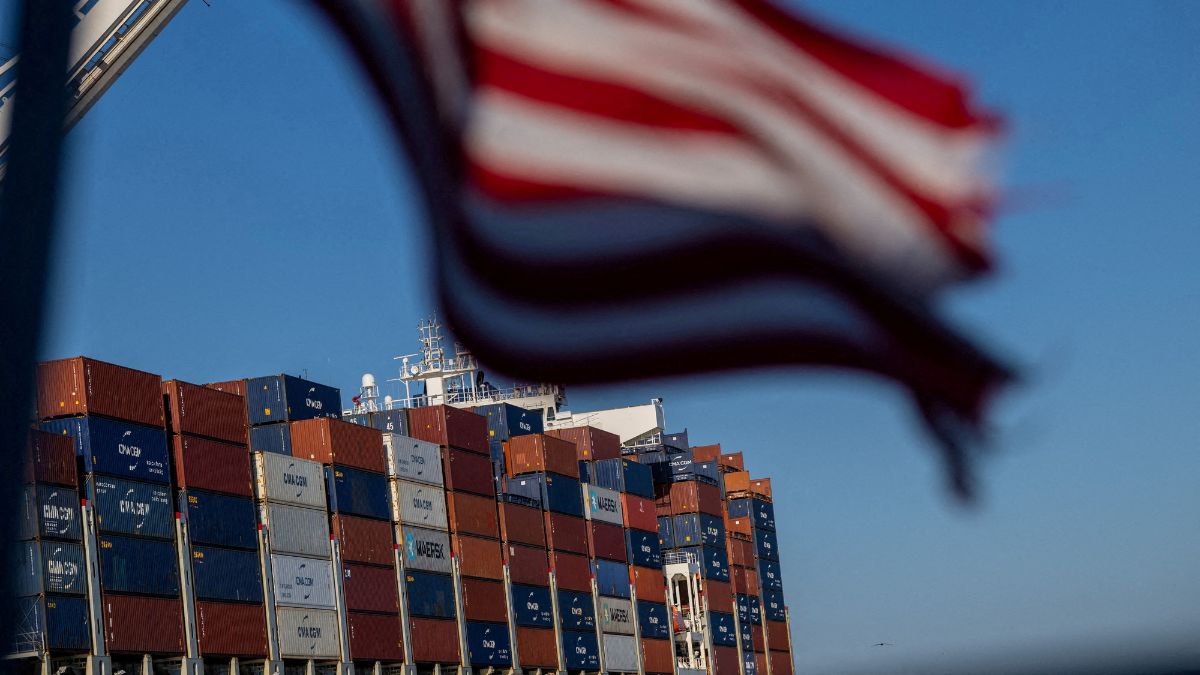United States President Donald Trump’s ambitious tariff campaign — aimed at altering global trade and rebuilding domestic manufacturing — has triggered a significant redistribution of costs within the US economy.
Despite the administration’s assertions that foreign exporters would ultimately shoulder the burden, an expanding body of research indicates that the majority of the impact is falling on American consumers and businesses.
According to new analysis by economists at Goldman Sachs Group Inc, US consumers are now expected to bear 55 per cent of the total cost of the tariffs, while American companies are absorbing 22 per cent, and foreign exporters approximately 18 per cent, with a further 5 per cent evaded through circumvention or compliance gaps.
These estimates, presented in a research note dated October 12, 2025, provide one of the clearest assessments yet of how Trump’s trade policies are reshaping the economic landscape.
Goldman’s economists Elsie Peng and David Mericle wrote that “US businesses are likely bearing a larger share of the costs” initially, as firms take time to pass on higher import prices to consumers.
Over time, however, the burden is shifting directly to households as companies raise prices to offset their increased costs.
“If recently implemented and future tariffs have the same eventual impact on prices as the tariffs implemented earlier this year, then US consumers would eventually absorb 55 per cent of tariff costs,” they added.
These findings come amid growing evidence that tariffs — introduced as part of Trump’s “America First” trade strategy — are contributing to persistent inflationary pressures across the economy.
Goldman Sachs estimates that the tariffs have already added 0.44 percentage points to the Federal Reserve’s preferred inflation gauge, with expectations that this could rise to 0.6 per cent if new tariffs on consumer goods such as furniture and kitchen equipment come into force.
What does the data say?
Trump’s latest round of tariffs — introduced over the past six months — covers an extensive range of imported goods, including copper, steel, aluminium, and several categories of automobiles and auto parts.
According to data compiled by the Yale Budget Lab, China faces duties as high as 28 per cent, while tariffs on imports from other major trading partners average around 16 per cent.
The effects of these measures are visible across US price indices. Figures from the Bureau of Labor Statistics show that consumer prices have risen steadily each month since April, when the president unveiled his new duties during what he described as “Liberation Day” for American manufacturing.
By August, the Consumer Price Index (CPI) stood at 2.93 per cent, while the core personal consumption expenditures (PCE) index preferred by the Federal Reserve rose to 2.7 per cent — both well above the Fed’s 2 per cent target.
Goldman Sachs analysts noted that the cumulative effect of the tariffs has lifted core personal consumption expenditure prices by 0.44 per cent, with their models suggesting that inflation could reach 3 per cent by the end of 2025 if additional levies proceed as planned.
These developments complicate the central bank’s effort to rein in price growth. Fed Chair Jerome Powell recently acknowledged that tariffs have contributed “perhaps 30-40 basis points” to the current core inflation reading of 2.9 per cent, though he has suggested that the impact might prove temporary.
A Boston Fed estimate placed the likely inflationary effect closer to 75 basis points, while the Peterson Institute for International Economics forecast that inflation could be one full percentage point higher over the next year compared with a scenario without tariffs.
The Trump administration, however, remains steadfast. Officials maintain that the costs of tariffs will ultimately be transferred to foreign exporters once global supply chains adjust.
In a statement, White House spokesman Kush Desai said, “The President and Administration’s position has always been clear: While Americans may face a transition period from tariffs upending a broken status quo that has put America Last, the cost of tariffs will ultimately be borne by foreign exporters. Companies are already shifting and diversifying their supply chains in response to tariffs, including by onshoring production to the United States.”
Who is really paying the price?
Harvard University Professor Alberto Cavallo, who has been analysing price movements across hundreds of thousands of goods, found that “most of the cost seems to be borne by US firms.”
In his ongoing research with Paola Llamas and Franco Vazquez, Cavallo has tracked prices for 359,148 products — ranging from carpets to coffee — sold by both major online and physical retailers.
Their findings reveal that since the introduction of Trump’s tariffs in early March, imported goods have become roughly 4 per cent more expensive, while domestically produced goods have increased by about 2 per cent.
The steepest price hikes have occurred in products that the United States either cannot produce in sufficient quantities — such as coffee — or that are sourced primarily from countries facing the highest tariffs, including Turkey and China.
Cavallo noted that the inflationary impact has been gradual, as many firms attempt to spread out price adjustments over time. “We have seen a gradual pass-through to consumer prices and there’s a clear upward pressure,” he said.
Further analysis by Yale University’s Budget Lab supports the view that foreign exporters are not significantly absorbing US tariffs.
“This suggests foreign producers are not absorbing much if any of the U.S. tariffs, consistent with prior economic research,” the researchers wrote.
These findings challenge one of the administration’s key arguments: that other countries would foot the bill for tariffs.
In practice, importers in the United States pay the levies at the point of entry through US Customs and Border Protection, and businesses either absorb these costs or pass them along to consumers.
The Goldman Sachs data suggest that US businesses initially carry much of the burden, but as inventories deplete and margins compress, the pressure shifts downstream to consumers.
Trump himself has publicly criticised Goldman Sachs and its chief executive, David Solomon, for previous assessments suggesting that American consumers bore a disproportionate share of tariff costs.
“They made a bad prediction a long time ago on both the Market repercussion and the Tariffs themselves, and they were wrong, just like they are wrong about so much else,” the president wrote in August on his social media platform.
How has this contributed to inflation?
The cumulative impact of tariffs is adding to a broader inflationary environment that has persisted despite efforts by the Federal Reserve to stabilise prices.
While inflation rates have declined from their post-pandemic highs, they remain elevated enough to affect household spending and consumer sentiment.
Trump’s protectionist approach has pushed average import taxes from around 2 per cent before 2025 to an estimated 17 per cent today, based on data from multiple think tanks. The resulting duties — worth approximately $30 billion per month — have rippled across global supply chains.
Analysts note that the price increases associated with tariffs are generally smaller than the actual tariff rate, implying that both foreign suppliers and US importers are absorbing part of the cost.
However, this distribution still leaves a substantial share for consumers.
US import prices, which exclude tariffs, show that foreign exporters have increased their dollar-denominated prices, passing on some of the cost associated with the weakening of the US currency.
Corporate responses vary widely. European carmakers have thus far attempted to absorb much of the impact to preserve market share, while consumer goods companies such as Procter & Gamble, EssilorLuxottica, and Swatch have opted to raise retail prices in the United States.
A Reuters tracker covering firms across Europe, the Middle East, and Africa found that 72 per cent of companies have implemented price hikes since the new trade measures were introduced, though only 18 companies reported reductions in profit margins.
Online retail platforms such as Shein and Amazon have also reflected these changes, showing notable increases in the prices of Chinese-manufactured items, including clothing, electronics, and household goods.
Meanwhile, China’s internal policy shifts — particularly its “anti-involution” campaign, which encourages producers to cut competition and limit overcapacity — could further restrict supply in key sectors such as solar energy equipment, amplifying the inflationary effect in global markets.
How has this affected global trade flow?
Data from S&P Global surveys of purchasing managers indicate that new export orders have been contracting globally since June, a trend mirrored in trade statistics from the World Trade Organization (WTO) and several independent research institutions.
According to the WTO’s latest forecast, global merchandise trade volume growth is expected to slow sharply to 0.5 per cent in 2026, citing the delayed effects of the new US tariffs.
The Kiel Institute for the World Economy, a German think tank, has observed a clear downtrend in American shipment data, suggesting that trade volumes are already feeling the pinch.
The European Union’s exports to the United States fell by 4.4 per cent year-on-year in July, while Germany — a key industrial hub within the bloc — saw its US exports plunge by 20.1 per cent in August.
Economists at ING Bank project a 17 per cent decline in EU exports to the US over the next two years, potentially reducing the bloc’s GDP growth by 30 basis points.
“The expected impact of U.S. tariffs hasn’t materialised yet,” Ruben Dewitte, an economist at ING told Reuters. “We anticipate these effects will become more visible in the coming months.”
The disruption has also triggered adjustments among multinational corporations as they attempt to navigate new trade barriers. Many firms are diversifying supply chains to reduce reliance on China and other targeted markets.
While the White House has described this as evidence of a long-term strategic realignment, economists caution that such transitions are costly and take time to yield tangible benefits.
How have Trump & Co. reacted?
Despite the mounting economic strain, the Trump administration has repeatedly defended the tariffs as both a revenue source and a tool to protect national interests.
According to the US Treasury Department, tariff revenues reached $31 billion in September, bringing the year-to-date total to approximately $215 billion.
The White House has floated several proposals for using these funds. Among the ideas under discussion are rebate checks for American households and subsidies for farmers and manufacturers affected by retaliatory trade measures.
White House Press Secretary Karoline Leavitt recently confirmed that part of the revenue may be redirected to sustain the Special Supplemental Nutrition Programme for Women, Infants, and Children (WIC), which has been disrupted by the ongoing government shutdown.
Critics argue that these fiscal gains pale in comparison to the broader economic cost. As the Goldman Sachs report notes, the current round of tariffs has already raised the cost of living and eroded consumer purchasing power, even before considering Trump’s threat to impose 100 per cent tariffs on Chinese imports and new restrictions on “critical” US software exports.
“We are not assuming any changes to tariff rates on imports from China, but events in recent days suggest large risks,” the Goldman analysts cautioned.
The US Supreme Court’s scheduled hearing on November 5 is expected to clarify the legal boundaries of the president’s tariff authority, while markets await clarity on whether additional levies on consumer products will proceed.
Also Watch:
With inputs from agencies


)

)
)
)
)
)
)
)
)



